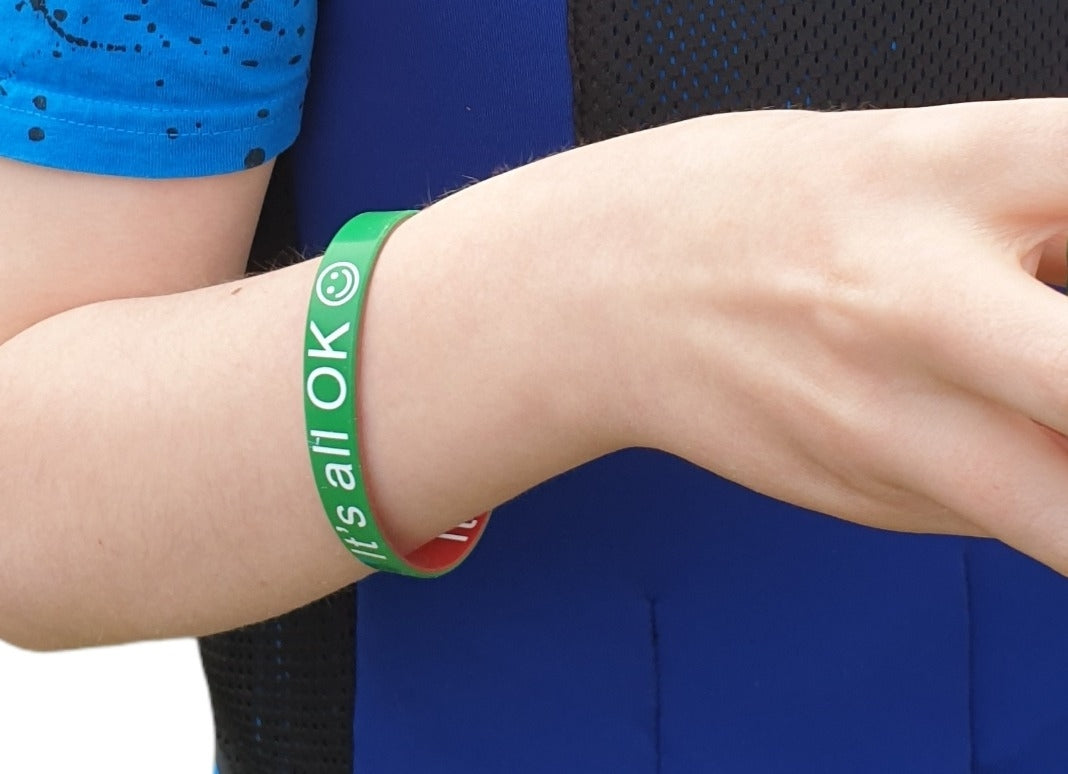Emotions Mood reversible wristbands-Available in 2 sizes
Emotions Mood reversible wristbands-Available in 2 sizes
Couldn't load pickup availability
Those who struggle to communicate their emotions may find Emotion Bands helpful. Emotion Bands can be a simple way for them to communicate their general mood to those around them. Our silicone Emotion Band bracelets have two sides. One side has a red background and a frowning face, while the other side has a green background and a smiling face. These universal signals let kids show that they're comfortable with someone approaching them, or that they're overwhelmed and need help to calm down.
Who Can Use Emotion Bands?
Emotion Bands can be helpful for anyone. Some groups of people may find them particularly useful. These include:
Those who struggle with verbal skills when they are upset or stressed. They can simply flip their bracelet from green to red. This shows that they need time to calm down without needing to speak. It can signal to caregivers that they need access to accommodations in the moment.
Kids who are non-verbal don't use spoken language but are still able to communicate. Emotion Bands give them a way to show those around them that they’re having a good day or a bad one. This helps them create independence and feel more in control.
When Are Emotion Bands Useful?
Emotion Bands can be useful in a variety of situations.
Emotion Bands can help kids share their emotions in school settings, without disrupting the classroom. Flipping their bracelet can signal that they are becoming overwhelmed. This can alert an aide who can help them get to a space where they can regulate.
Occupational and physical therapy can be hard for kids. They may get tired, upset, or frustrated. All these emotions can make it harder to communicate with words. Flipping the Emotion Band can signal the therapist that the kid needs a break, and also let them know when the child is ready to resume work.
Emotion Bands could also find use in more customised ways if needed. When students need to show if they’re happy with a proposed solution or not, they could use the band to indicate that, for example.
How Do Kids Benefit From Emotion Bands?
Emotion bands are great for kids who struggle with communication. Even kids who have high verbal skills while they’re calm may find it hard to use verbal speech when they’re upset, physically uncomfortable, or out of their routine. Staff or caregivers may not realise that these kids need communication boards or other AAC tools at these times.
Emotion Bands can be an easy signal to those around a child to switch into a different mode of communication. They can better support the child to get what they need and access appropriate tools. When kids can communicate on their own, they have fewer inappropriate behaviours in school or therapeutic sessions and can connect more easily to the other kids and staff members around them.
Emotion Bands can also be useful at home. Some kids put in a lot of work during the day to get through and perform as well as possible. When they get home, they can feel exhausted, which can make it difficult to keep up with rules at home. Kids can use their bracelet on the way home to show how the day went. When parents know how their kids are feeling, they can make the right decisions about how to support their child throughout the evening.
These bracelets are not suitable for chewing; for kids who tend to chew on rubbery or silicone items, use these bracelets with caution. Emotion Bands are sold per piece.
The emotion bracelet is a silicone bracelet which allows the wearer to indicate how you feel so that people in the environment can take this into account. For example, if you are over-stimulated and do not want others to talk to you, you wear your bracelet with the red side (sad faces) displayed. If you are happy and you are open to be addressed, then flip the bracelet around and wear the green side (happy faces) upwards.
Sizing – available in two sizes –
Small – 18.0cm band length x 1.2cm deep x 0.2cm thick (child size)
Large – 20.2cm band length x 1.2cm deep x 0.2cm thick (older child or adult size)
Share


















